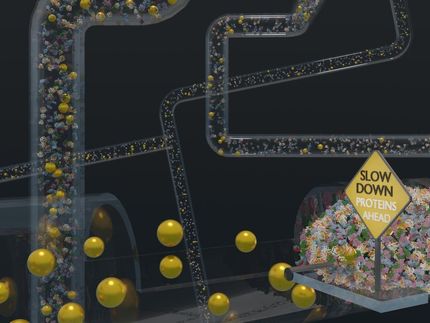Breakthrough in molecular machines
Researchers have succeeded to obtain control of the molecular machines, which in the future may enable them to perform controlled movements
Molecules are some of life's most basic building blocks. When they work together in the right way, they become molecular machines that can solve the most amazing tasks. They are essential for all organisms by, for example, maintaining a wide range of cellular functions and mechanisms.

Artist interpretation of a molecular machine.
Mikkel Larris, University of Southern Denmark
What if you could create and control an artificial molecular machine? And make it perform tasks that serve us humans?
Many researchers are looking for ways to create and control such molecular machines, and research is going on in labs all over the world.
Hot study attracts attention
At University of Southern Denmark, Ph.D. Rikke Kristensen and colleagues from Professor Jan O. Jeppesen's research group at the Department of Physics, Chemistry, and Pharmacy have published a scientific study on molecular machines that have attracted attention.
The study is published in the journal Chemistry -- A European Journal and has been published both as a so-called Hot Paper and as a Cover Feature.
Before a research result can be published in a scientific journal, it must be evaluated by a number of scientific peers, and in this case the reviewers have considered the study to be of great significance.
What attracts attention is that the researchers have succeeded to obtain control of the molecular machines, which in the future may enable them to perform controlled movements.
Into your body
- In principle, this means that you can send the machine off to the place, where you want it to perform its function, says Rikke Kristensen.
One example could be to pack a molecular machine into a tablet of medicine and use it to control when the drug gets released.
The challenge of medicine today is that the active components must be well protected while being transported through the body, so they don't get degraded or released before they reach their destination in the body - but they also need to be released when they do reach their destination.
And into your brain
- If a molecular machine is built into the tablet, it can help when the active components in the tablet reaches their destination; then the molecular machine can help open the tablet and allow the active components to be released so they can do their job where needed, says Rikke Kristensen.
Optimal delivery of active components to destinations in the body is a huge challenge for anyone developing new drugs, and it is particularly difficult to deliver active components to the brain.
The so-called blood/brain barrier is one of the most impenetrable barriers in the human organism.
Small dirt-removing machines
Another example is to include molecular machines in coating products that are added to surfaces: Activating the motions of the molecular machines will change the properties of the surface and thereby remove the dirt from the surface.
And then there are the small computers: Molecular machines have the potential to give us organic computers that are a hundred times smaller than the computers we know today.
- Future applications are fascinating, but it is important to remember that for now, this is basic and not applied science, says Professor and Principle Investigator Jan O. Jeppesen.
- Right now, we approach this field with curiosity and a desire to understand what happens, when we begin to tamper with nature's smallest building blocks. Where it all ends and what use our descendants can find for this in the future, we cannot predict, says Jan O. Jeppesen.
He continues:
- When electricity was invented, nobody could predict how it would affect the world. In a way, it is the same here; we are faced with something new that we may not fully understand today. Maybe people will laugh at our ideas in 50 years. Maybe the ideas will be surpassed. I can't tell you.
In short, the researchers' breakthrough is that they have succeeded in controlling the molecular machines so that they can be controlled to move only in one direction.
- It's a big step forward. So far, we have been able to move a molecular machine - but only between two points. Now, in principle, we can send the machine off in a desired direction for as long as we want to, explains Rikke Kristensen and continues:
- It is like having a car wheel that can only rotate back and forth for half a turn (between two points). That does not give the car momentum. If you want the car to move forward, the wheels must rotate in a certain direction as long as you want them to do so. Similarly, it is important that a molecular machine can move in the same direction for the desired period of time.



























































